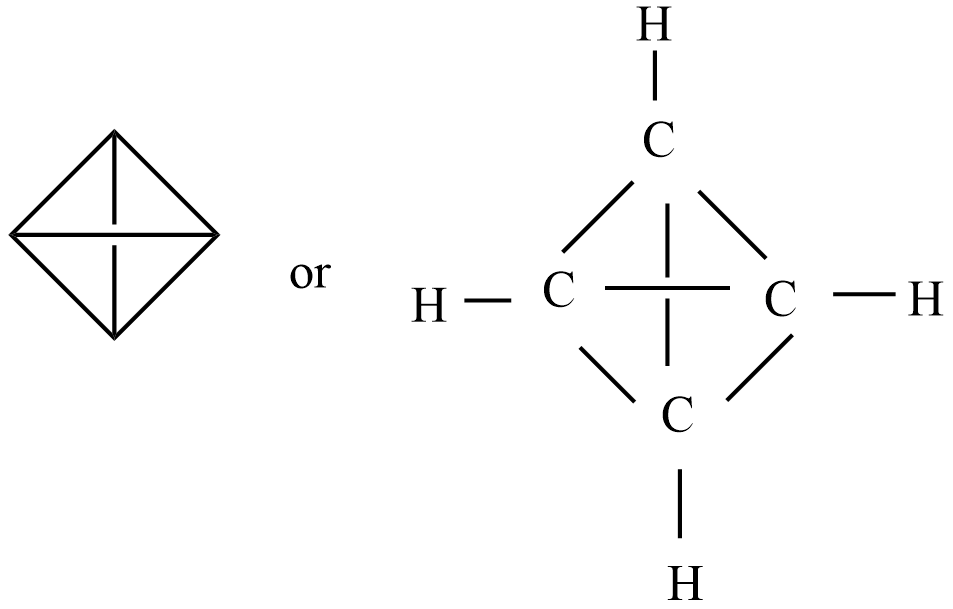
The double bond equivalent for tetrahedron

(A) 2
(B) 3
(C) 4
(D) 5

Answer
484.2k+ views
1 likes
Hint: The number of unsaturation present in the molecule is known as DBE or double bond equivalent. In a ring system or double bond referrers the term unsaturation. For example, benzene has 3 double bonds and 1 ring which gives double bond equivalent value 4. If an organic compound has the presence of an oxygen atom does not influence the double bond equivalent calculation.
Complete step by step solution:
A double bond equivalent for an organic compound can be calculated by the given formula.
DBE = double bond equivalent of unsaturation
C = number of carbon atoms present in the organic compound
H = number of hydrogen atoms present in the given organic compound
X = number of halogens atoms present like Cl, Br, or I
N = number of nitrogen atoms present in the given organic compound.
Given organic compound – tetrahedrane and chemical formula is
The number of carbons present in the given organic compound = 4
Then the number of hydrogen atoms present in the given organic compound = 4
There is no number of nitrogen and halogen atoms.
From equation (1),
Hence, the double bond equivalent for tetrahedron is 3.
So, the correct answer is option B.
Note: The arrangement of atoms and the chemical bonds that hold the atoms together in the chemical structure of this tetrahedrane contains a total of 10 bonds. There are 4 three-membered rings, 3 four-membered rings, and 6 non-H bonds.
Complete step by step solution:
A double bond equivalent for an organic compound can be calculated by the given formula.
DBE = double bond equivalent of unsaturation
C = number of carbon atoms present in the organic compound
H = number of hydrogen atoms present in the given organic compound
X = number of halogens atoms present like Cl, Br, or I
N = number of nitrogen atoms present in the given organic compound.
Given organic compound – tetrahedrane and chemical formula is
The number of carbons present in the given organic compound = 4
Then the number of hydrogen atoms present in the given organic compound = 4
There is no number of nitrogen and halogen atoms.
From equation (1),
Hence, the double bond equivalent for tetrahedron is 3.
So, the correct answer is option B.
Note: The arrangement of atoms and the chemical bonds that hold the atoms together in the chemical structure of this tetrahedrane contains a total of 10 bonds. There are 4 three-membered rings, 3 four-membered rings, and 6 non-H bonds.
Latest Vedantu courses for you
Grade 10 | MAHARASHTRABOARD | SCHOOL | English
Vedantu 10 Maharashtra Pro Lite (2025-26)
School Full course for MAHARASHTRABOARD students
₹31,500 per year
Recently Updated Pages
Express the following as a fraction and simplify a class 7 maths CBSE

The length and width of a rectangle are in ratio of class 7 maths CBSE

The ratio of the income to the expenditure of a family class 7 maths CBSE

How do you write 025 million in scientific notatio class 7 maths CBSE

How do you convert 295 meters per second to kilometers class 7 maths CBSE

Write the following in Roman numerals 25819 class 7 maths CBSE

Trending doubts
State and prove Bernoullis theorem class 11 physics CBSE

What are Quantum numbers Explain the quantum number class 11 chemistry CBSE

Write the differences between monocot plants and dicot class 11 biology CBSE

1 ton equals to A 100 kg B 1000 kg C 10 kg D 10000 class 11 physics CBSE

State the laws of reflection of light

In northern hemisphere 21st March is called as A Vernal class 11 social science CBSE




